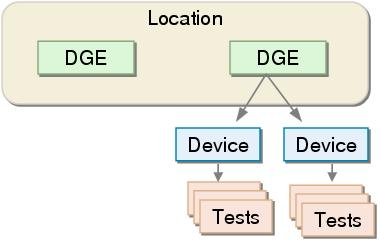DGEs
A DGE is the Data Gathering Engine. The DGE polls devices for various tests such as CPU and bandwidth utilization and aggregates the data that it gathers. Generally, a DGE is physically near the devices that it monitors. A DGE can typically monitor approximately 500 - 1,500 devices. See Disk Space Requirements for DGE Aggregation for sizing algorithms).
DGE Locations
A DGE location is a collection of one or more DGEs that are automatically load balanced for provisioned tests. The DGEs within a single DGE Location are usually located in the same physical region, but they can be separate in some special situations. When you provision a device to begin monitoring it, you assign it to a DGE Location, not to an individual DGE. If there is more than one DGE at that location, Traverse automatically assigns the device to the least loaded DGE.

Relationship Between Locations, DGEs, Devices, and Tests
DGE Extensions
The cloud-base version of Traverse requires users to install a Data Gathering Engine extension (DGE extension) on any network they want to monitor. The DGE extension relays data from the network you are monitoring to the DGE component of your Traverse cloud website. The DGE performs the actual polling of data, receives SNMP traps, generates alarms based on thresholds, and does the aggregation of data in real time. When you install a DGE extension for your local network, you are asked to identify the "upstream" DGE that your DGE extension will relay data to.
If you are using firewalls within the data center, you must configure access through the firewalls to enable the monitoring of the devices behind them. Also, if you are using Network Address Translation (NAT) or a private address space, the IP address must be unique within the data center.